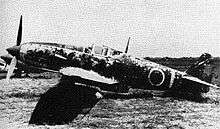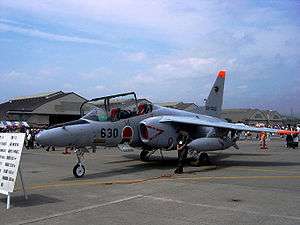Kawasaki Aerospace Company
|
| |
| Division of Kawasaki Heavy Industries | |
| Industry | aerospace manufacturing |
| Founded | 1918 |
| Headquarters |
Minato, Tokyo, Japan Chūō-ku, Kobe, Japan |
| Products | Aircraft, Space systems, Simulators, Jet engines, Missiles, Electronic equipment |
| Website | Kawasaki Aerospace Company |
Kawasaki Heavy Industries Aerospace Company (川崎重工業航空宇宙カンパニー Kawasaki Jūkōgyō Kōkūuchū Kanpanii) is the aerospace division of Kawasaki Heavy Industries. It produces aircraft, space systems, simulators, jet engines, missiles, and electronic equipment.
History
Pre-war genesis
Kawasaki Aircraft Industries (川崎航空工機業株式会社 Kawasaki Kokuki Kogyo K.K.) was one of Japan's first aircraft companies. It developed numerous types of aircraft for the Imperial Japanese Army during the 1930s and 1940s. In the post-war era, it produced numerous aircraft under license from American manufacturers for Japan Air Self-Defense Force and Japan Maritime Self-Defense Forces. The company became part of Kawasaki Heavy Industries (KHI) in 1969.
Kawasaki Aircraft Industries was founded in 1918 as subsidiary of heavy-industrial conglomerate Kawasaki Heavy Industries in Kobe. Prior to the end of World War II Kawasaki mostly supplied aircraft and aircraft engines to the Imperial Japanese Army Air Force (IJAAF).

In the early 1930s, Kawasaki built Salmson biplanes and engines under license, and also developed a number of its own designs. Kawasaki hired the noted German Aerospace engineer and designer, Dr. Richard Vogt, from 1923-1933 to assist with design work and to train Japanese engineers. Among Vogt's pupils was Takeo Doi the future chief designer for Kawasaki. Vogt later went on to become chief designer for Blohm & Voss.
Kawasaki obtained a license from Dornier for all-metal construction flying boats, and the Kawasaki-Dornier Wal made a notable flight in December 1924; however, Kawasaki thereafter specialized in land planes. Noted designs include the:
- Ka 87 - twin-engine bomber aircraft (1926)
- Type 88 - single-engine reconnaissance biplane (1927)
- Type 92 - single-seat biplane fighter (1930)
- Ki-3 - single-engine biplane bomber (1933)
- Ki-5 - single-engine experimental fighter (1934)
- Ki-10 - single-seat fighter biplane (1935)
- Ki-28 - single-engine experimental fighter (1936)
- Ki-32 - single-engine monoplane bomber (1937)
- Ki-45 - twin-engine fighter (1939)
- Ki-48 - twin-engine light bomber (1939)
- Ki-56 - twin-engine light transport (1940)
- Ki-60 - single-engine experimental fighter (1941)
- Ki-61 - single-seat fighter (1941)
- Ki-64 - singe-seat fighter (1943)
- Ki-88 - single-seat fighter (not built)
- Ki-96 - twin-engine experimental fighter (1941)
- Ki-100 radial-engine fighter (1944)
- Ki-102 - twin-engine fighter (1944)
- Ki-148 - air-to-surface missile (1944)
Post-war development
During the occupation of Japan after the end of World War II, all of Japan's aerospace industry was dismantled, designs destroyed and plants converted to other uses. After the ban on aircraft development was lifted, in March 1954, a new company was founded by the merger of subsidiary companies K.K. Kawasaki Gifu Seisakusho and Kawasaki Kikai Kogyo K.K., retaining the name of the pre-war Kawasaki Kokuki Kogyo KK,
The Kawasaki KAL-1 (July 1953) was the first postwar all-metal aircraft of Japanese design. Early production covered 210 Lockheed T-33 jet trainers, 48 Lockheed P-2H Neptune maritime patrol aircraft and 239 Bell 47 helicopters, all under license from the United States. Kawasaki was also a major subcontractor for components for the domestically-developed NAMC YS-11 turboprop transport.
Kawasaki Kokuki K.K. was dissolved and became a division of the reorganized Kawasaki Heavy Industries (KHI) in April 1969.
Under Kawasaki Heavy Industries

In April 1969, the former Kawasaki Kokuki K.K. was dissolved and became a division of the reorganized Kawasaki Heavy Industries (KHI). Kawasaki is a major contractor for the Japanese Ministry of Defense. Although in November 1970, Kawasaki completed Japan's first domestically designed twin turbofan military transport, the C-1, the company concentrated primarily on licensed production of derivatives of American patrol aircraft and helicopters through the 1990s. Kawasaki built 82 P-2Js (derived from the Lockheed P-2 Neptune), 211 KH-4 helicopters (derived from the Bell 47), 160 Kawasaki KV-107 helicopters (derived from the Boeing Vertol 107 Model II), and Hughes/McDonnell Douglas Model 500D and OH-6DA helicopters. Kawasaki also built 101 P-3C antisubmarine warfare patrol airplanes plus four EP-3/UP-3D electronic intelligence/training variants, and 68 CH-47J / JA.
In the 1990s, Kawasaki became prime contractor on the new OH-1 armed scout, observation and attack helicopter (first flown August 1996), and completed some 200 T-4 intermediate jet trainers and liaison aircraft for the JASDF by 1998. It is currently developing two large, next-generation aircraft, the XP-1 maritime patrol airplane and the XC-2 transport aircraft.
Kawasaki also continues to build helicopters, including the BK117, jointly developed and manufactured with MBB. Kawasaki began delivery of MCH-101 mine sweeping and transport helicopter in 2006 to Japan Maritime Self-Defense Force.[1]
In the commercial aviation business, KHI is involved in the joint international development and production of large passenger aircraft. It is involved in joint development and production of the Boeing 767 and Boeing 777 with The Boeing Company, and the 170, 175, 190 and 195 jets with Empresa Brasileira de Aeronáutica. It is also involved in the joint international development and production of turbofan engines for passenger aircraft such as the V2500, the RB211/Trent, the PW4000 and the CF34.
Kawasaki also works for the Japan Aerospace Exploration Agency. KHI was responsible for the development and production of the payload fairings, payload attach fittings (PAF) and the construction of the launch complex for the H-II rocket. It continues to provide services for the H-IIA rocket.
Main products
- Aircraft
- Kawasaki C-1 - twin-turbofan military transport
- Kawasaki C-2 - advanced military transport
- Kawasaki KAT-1 - primary training aircraft
- Kawasaki KH-4 - light utility helicopter
- Kawasaki OH-1 - light reconnaissance helicopter
- OH-6 Cayuse light reconnaissance helicopter
- Kawasaki P-1 - advanced maritime patrol aircraft
- Kawasaki P-2J - maritime patrol aircraft
- Kawasaki T-4 - intermediate jet trainer
- Kawasaki YPX - proposed airliner
- MBB/Kawasaki BK 117 - utility, transport helicopter
- Space systems
- Simulators
- Jet engines
- Missiles
- Type 64 MAT - anti-tank missile
- Type 79 Jyu-MAT - anti-tank/landing-craft missile
- Type 87 Chu-MAT - anti-tank missile
- Type 96 Multi-Purpose Missile System - anti-tank/landing-craft missile
- Type 01 LMAT - anti-tank missile
- Middle range Multi-Purpose missile
- Electronic equipment
- Unmanned Aerial Vehicles
- Kawasaki KAQ-1 - aerial target drone
References
- ↑ "MCH-101 Airborne Mine Countermeasures (AMCM)". Globalsecurity.org. Retrieved 2009-12-17.